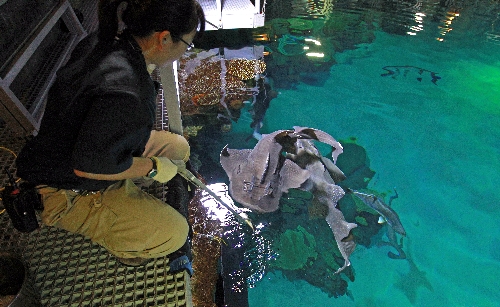Sharks not really voracious eaters

One important thing you need to know about sharks: They’re not all that hungry.
At least, not in a way that humans can imagine, says Jack Jewell, curator of the Shark Reef at Mandalay Bay.
So watching them eat – which they do every Monday, Wednesday and Friday at the aquarium — isn’t as cool as you might think. It’s fascinating and interesting and certainly educational. But it’s nothing like the way Hollywood depicts it: a churning, bloody frenzy in the water as the sharks devour massive amounts of meat.
Instead, Shark Reef employees use a long pole, or a giant shark fork, to dangle bites of fish in the water. Sharks then swim by and take the food. Or not. Depends on whether they want it, Jewell says. Again, sharks aren’t all that hungry.
The Shark Reef’s animals — sandbar, zebra, reef, sand tiger and Galapagos sharks — subsist on a diet of mackerel, herring, krill, scallops and squid, among other seafood. They don’t eat buckets and buckets of it, either. A shark eats 1 percent to 2 percent of its body weight a week, Jewell says, an amount that a human could easily eat in a day.
It’s squid day on this recent Wednesday, which is sort of like declaring an all-broccoli day for a kid. For whatever reason, sharks don’t care much for squid, Jewell says, but it’s good for them. Four aquarium employees position themselves around the shark tank, each with his or her own shark fork, and proceed to feed 30 sharks, one by one. It takes forever. Or 2½ hours.
While the animals eat their allotment of 1 pound of squid, Jewell dispenses neat factoids about them. Sharks digest food down to a small amount of liquid so their waste is almost indiscernible. They also can push their lower intestines out of their bodies to rinse them of debris and then suck them right back in, Jewell explains. Fascinating but probably more than you wanted to know.
Larger sharks, such as the sand tigers, don’t move around as much as smaller ones, such as the sandbar sharks, so they aren’t as hungry. And they’ll pass on a piece of food if it’s not to their liking.
When aquarist Kate Foster lowers her shark fork into the water with a piece of squid on the end, a sand tiger shark glides by. Big Mama is her nickname, and she’s not interested. Usually, she’s all about the food, Foster says. Eventually, Big Mama circles back, and this time, she’s hungry. With a flick of her tail and a quick jerk to the right, she snaps her mouth around the squid.
On the other side of the tank, the water’s roiling a bit more where the sandbar sharks are eating. Their feeding pattern is much more active, their bodies slicing through the water, fast and furtive.
People always ask how much fish food the aquarium goes through in a month, but it’s not as impressive as one might imagine, Jewell says. They serve about 500 pounds of some of the finest seafood on the market, as Shark Reef’s supplier is the same one used by the hotel’s restaurants.
Food preparation is a major part of the Shark Reef’s operations; it has a dedicated area with a refrigerator, walk-in freezer, cooler and prep tables. Reptiles and other animals that aren’t in the shark tank are on separate eating schedules so feedings are an ongoing process, Jewell says.
Jackfish, sawfish, nurse sharks, sea turtles and Creole fish are among the 1,500 other animals that live with the sharks. They are fed on the same schedule but in a different way.
The Shark Reef uses a system in which specific animals eat in designated areas of the tank. This is to keep the aggressive fish from getting all the food and to prevent fights from breaking out, Jewell explains.
Contact reporter Sonya Padgett at spadgett@reviewjournal.com or 702-380-4564.